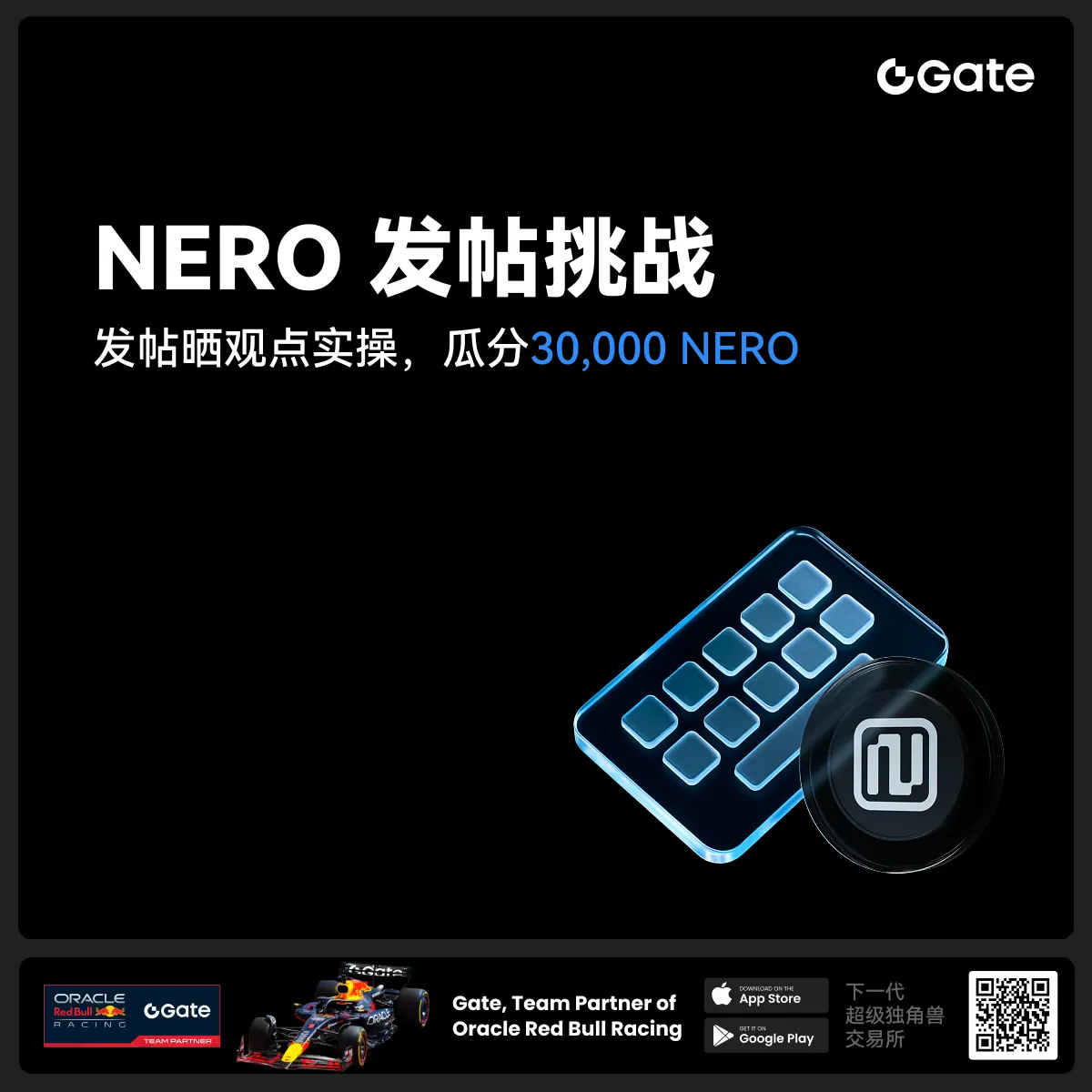- 话题1/3
42k 热度
30k 热度
46k 热度
9k 热度
21k 热度
- 置顶
- 🎉 #CandyDrop合约挑战# 正式开启!参与即可瓜分 6 BTC 豪华奖池!
📢 在 Gate 广场带话题发布你的合约体验
🎁 优质贴文用户瓜分$500 合约体验金券,20位名额等你上榜!
📅 活动时间:2025 年 8 月 1 日 15:00 - 8 月 15 日 19:00 (UTC+8)
👉 活动链接:https://www.gate.com/candy-drop/detail/BTC-98
敢合约,敢盈利
- 🎉 攒成长值,抽华为Mate三折叠!广场第 1️⃣ 2️⃣ 期夏季成长值抽奖大狂欢开启!
总奖池超 $10,000+,华为Mate三折叠手机、F1红牛赛车模型、Gate限量周边、热门代币等你来抽!
立即抽奖 👉 https://www.gate.com/activities/pointprize?now_period=12
如何快速赚成长值?
1️⃣ 进入【广场】,点击头像旁标识进入【社区中心】
2️⃣ 完成发帖、评论、点赞、发言等日常任务,成长值拿不停
100%有奖,抽到赚到,大奖等你抱走,赶紧试试手气!
截止于 8月9日 24:00 (UTC+8)
详情: https://www.gate.com/announcements/article/46384
#成长值抽奖12期开启#
- 📢 Gate广场 #NERO发帖挑战# 秀观点赢大奖活动火热开启!
Gate NERO生态周来袭!发帖秀出NERO项目洞察和活动实用攻略,瓜分30,000NERO!
💰️ 15位优质发帖用户 * 2,000枚NERO每人
如何参与:
1️⃣ 调研NERO项目
对NERO的基本面、社区治理、发展目标、代币经济模型等方面进行研究,分享你对项目的深度研究。
2️⃣ 参与并分享真实体验
参与NERO生态周相关活动,并晒出你的参与截图、收益图或实用教程。可以是收益展示、简明易懂的新手攻略、小窍门,也可以是行情点位分析,内容详实优先。
3️⃣ 鼓励带新互动
如果你的帖子吸引到他人参与活动,或者有好友评论“已参与/已交易”,将大幅提升你的获奖概率!
NERO热门活动(帖文需附以下活动链接):
NERO Chain (NERO) 生态周:Gate 已上线 NERO 现货交易,为回馈平台用户,HODLer Airdrop、Launchpool、CandyDrop、余币宝已上线 NERO,邀您体验。参与攻略见公告:https://www.gate.com/announcements/article/46284
高质量帖子Tips:
教程越详细、图片越直观、互动量越高,获奖几率越大!
市场见解独到、真实参与经历、有带新互动者,评选将优先考虑。
帖子需原创,字数不少于250字,且需获得至少3条有效互动
- 🎉 亲爱的广场小伙伴们,福利不停,精彩不断!目前广场上这些热门发帖赢奖活动火热进行中,发帖越多,奖励越多,快来GET你的专属好礼吧!🚀
1️⃣ #GateLaunchpad上线IKA# |IKA认购体验
在Gate广场带话题晒出你的IKA Launchpad认购体验,4位幸运分享者讲瓜分$200分享奖池!
详情 👉️ https://www.gate.com/post/status/12566958
2️⃣ #ETH冲击4800# |行情分析预测
大胆发帖预测ETH走势,展示你的市场洞察力!10位幸运用户将平分0.1 ETH 奖励!
详情 👉️ https://www.gate.com/post/status/12322403
3️⃣ #创作者活动第二期# |ZKWASM话题
在广场或推特发布与 ZKWASM 或其交易活动相关的原创内容,瓜分4,000枚ZKWASM!
详情 👉️ https://www.gate.com/post/status/12525794
4️⃣ #Gate广场征文活动第二期# |ERA话题
谈谈你对ERA的观点/体验,参与并推广活动,700 ERA大奖等你赢!
详情 👉️ https://www.gate.com/post/status/12361653
5️⃣ #MBG任务挑战# |MBG话题
分享你对MBG的洞察,积极参与和推广MBG活动,20位小 - 🎉Gate 2025 上半年社区盛典:内容达人评选投票火热进行中 🎉
🏆 谁将成为前十位 #Gate广场# 内容达人?
投票现已开启,选出你的心头好
🎁赢取 iPhone 16 Pro Max、限量周边等好礼!
📅投票截止:8 月 15 日 10:00(UTC+8)
立即投票: https://www.gate.com/activities/community-vote
活动详情: https://www.gate.com/announcements/article/45974
Planck launches layer-0 blockchain for artificial intelligence
Planck, an infrastructure protocol targeting the artificial intelligence boom, has launched a layer-0 blockchain aimed at supporting decentralized AI networks, the company said Tuesday.
The blockchain is designed to serve as foundational infrastructure for AI applications, particularly those built for decentralized physical infrastructure networks (DePINs). These networks combine hardware, token incentives and distributed processing to create alternatives to centralized resources, such as cloud services.
The move aligns with a growing push within the crypto industry to bring Web3 principles of decentralization to AI development, a sector still dominated by centralized players such as OpenAI and Google.
“Currently, high-performance AI compute is heavily centralized in the hands of a few tech giants," a spokesperson for Planck told Cointelegraph.
Planck is one of several blockchain projects working on alternative approaches to AI decentralization. Bittensor, for example, focuses on decentralized machine learning, while Fetch.ai facilitates the creation of AI agents through its decentralized platform.
Planck says its blockchain will generate protocol revenue from transaction fees, SDK usage, and developer tooling. Meanwhile, GPU operators providing compute resources will be rewarded with the protocol's native token based on machine's uptime (proof-of-connectivity) and actual utilization (proof-of-delivery).
Related: AI advances audit coverage for innovative multi-language virtual machine
GPU rental and AI chip crunch
Most of Planck’s revenue comes from renting out GPUs and compute contracts. The company says its hourly, on-demand model slashes costs by up to 90% compared to traditional cloud services.
Since February, the company generated $1.5 million in revenue, mostly from renting GPU power. The company also competes with other infrastructure providers like Vast.ai, CoreWeave and Lambda, all of which are capitalizing on the ongoing AI chip shortage.
That shortage has fueled explosive growth in the GPU-as-a-service sector. According to Precedence Research, the market hit $4 billion in 2024 and is expected to grow at a 23% annual rate, reaching $32 billion by 2034.
“Centralized AI compute is prohibitively expensive. By decentralizing the GPU network, Planck can offer up to 90% cost savings,” a Planck spokesperson said.
Magazine: AI Eye: AI is good for employment says PWC — Ignore the AI doomers